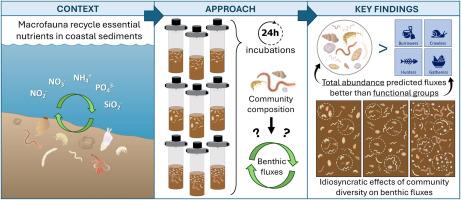Testing biodiversity-ecosystem function relations in nearshore marine sediments
IF 2.6
3区 地球科学
Q1 MARINE & FRESHWATER BIOLOGY
引用次数: 0
Abstract
Rapid biodiversity loss is raising concerns about potential declines in the functioning of Earth's ecosystems. Although decades of research explore biodiversity - ecosystem function (BEF) relations, empirical BEF assessments have lagged behind theoretical advances, particularly in marine benthic systems. Here, we incubate intact sediment push cores to examine the relationship between macroinfaunal community composition and benthic nutrient cycling in three nearshore sub-Arctic sites. First, we quantitatively assess potential effects of taxonomic and functional diversity, as well as community-weighted trait means, on oxygen and nutrient fluxes. Second, we examine fluxes in relation to macrofaunal abundance, oxygen consumption (a proxy for total core metabolism), and abundance of key functional groups, to test fundamental expectations based on ecological theory. We report distinct macrofaunal communities and contrasting benthic fluxes among sites, with oxygen and ammonium largely driving multivariate inter-site flux differences. Diversity indices and community-weighted trait means collectively explained ∼76 % of the variation in multivariate fluxes but provided little insight into the mechanistic links between diversity and functioning. In fact, we find that total macrofaunal abundance was the key driver of benthic fluxes at our sites, rather than functional community composition, which may have important implications for coastal conservation planning. Overall, our findings emphasize the highly context-dependent nature of BEF relationships and highlight the need to improve empirical understanding of these patterns in complex, natural ecosystems.

近岸海洋沉积物中生物多样性与生态系统功能关系的测试
生物多样性的迅速丧失引起了人们对地球生态系统功能可能下降的担忧。尽管几十年来的研究探索了生物多样性-生态系统功能(BEF)的关系,但实证BEF评估落后于理论进展,特别是在海洋底栖生物系统中。在这里,我们孵育完整的沉积物推岩心,以研究大型动物群落组成与亚北极近岸三个地点底栖生物营养循环之间的关系。首先,我们定量评估了分类和功能多样性以及群落加权性状对氧和养分通量的潜在影响。其次,我们研究了与大型动物丰度、耗氧量(总核心代谢的代表)和关键官能团丰度相关的通量,以检验基于生态学理论的基本预期。我们报告了不同的大型动物群落和不同地点之间的底栖生物通量,氧和铵在很大程度上驱动了多点间通量的差异。多样性指数和群落加权性状平均值共同解释了多元通量中约76%的变化,但对多样性和功能之间的机制联系提供的见解很少。事实上,我们发现在我们的站点中,大型动物的总丰度是底栖生物通量的关键驱动因素,而不是功能群落组成,这可能对海岸保护规划具有重要意义。总的来说,我们的研究结果强调了BEF关系的高度情境依赖性,并强调了在复杂的自然生态系统中提高对这些模式的经验理解的必要性。
本文章由计算机程序翻译,如有差异,请以英文原文为准。
求助全文
约1分钟内获得全文
求助全文
来源期刊
CiteScore
5.60
自引率
7.10%
发文量
374
审稿时长
9 months
期刊介绍:
Estuarine, Coastal and Shelf Science is an international multidisciplinary journal devoted to the analysis of saline water phenomena ranging from the outer edge of the continental shelf to the upper limits of the tidal zone. The journal provides a unique forum, unifying the multidisciplinary approaches to the study of the oceanography of estuaries, coastal zones, and continental shelf seas. It features original research papers, review papers and short communications treating such disciplines as zoology, botany, geology, sedimentology, physical oceanography.

 求助内容:
求助内容: 应助结果提醒方式:
应助结果提醒方式:


